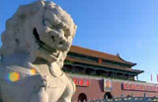Hong Kong police charge 6 with conspiracy to cause explosion
Updated: 2015-06-17 07:41
(Xinhua)
|
|||||||||||
 |
|
Police officers at a news conference, held on June 15, arrange air rifles seized with explosives in Hong Kong. Police in Hong Kong arrested nine people in raids and seized suspected contraband, authorities said. [Roy Liu/China Daily] |
HONG KONG - Five men and one woman were holding charged with "conspiracy to cause explosion" on Tuesday upon further investigations by the Hong Kong police.
The police Monday arrested 10 local residents, who were allegedly plotting to make bombs with explosives days ahead of this week's Legislative Council vote on a universal suffrage package.
The six people who were charged will appear before Kwun Tong Magistrates' Court on June 17. The remaining one male and three female were released on bail pending further investigations and are required to report back to the police in mid-July.
The police said the investigation is still ongoing. The likelihood of further arrests is not excluded.
In the light of this case and risk assessment, the police have launched an operation code-named "Jointbuilder" on Tuesday. Apart from stepping up patrol in various districts, officers will visit companies selling chemicals or chemical products to conduct investigation and take enforcement action to combat such crime if necessary.
The police also remind the public that manufacturing or conspiring to manufacture explosives is a very serious offense. According to Section 54 of the Crimes Ordinance (Cap. 200), the maximum penalty upon conviction will be 20 years' imprisonment.
The police Monday found maps marking locations in Wan Chai and Admiralty, two of Hong Kong's commercial districts, and seized several km of suspected solid explosives and five liters of liquid explosives at a "bomb factory" in Sai Kung of the New Territory.
The police also seized at one suspect's home explosives which were confirmed to be ingredients for triacetone triperoxide or TATP, a highly explosive substance that was used in the 2005 London bombings.
Related Stories
9 arrested in plot to bomb 2 city districts 2015-06-16 07:42
HK moves toward true universal suffrage 2015-06-16 07:52
Former member of HK SAR chief's election committee voices support to universal suffrage plan 2015-06-15 19:23
HK 'democrats' go against mainstream opinion 2015-06-10 07:40
HK reveals universal suffrage package for 2017 leader 2015-04-22 11:25
Central govt says HK universal suffrage package 'legal', 'practical' 2015-04-22 13:37
Today's Top News
China looks for a place in EC investment fund
Bank of China joins gold auction as first Asian bank
JF-17 fighter makes debut at Paris air show
Russia says will retaliate if US weapons stationed on its borders
Migrant crisis deepens in Italy, interior minister urges EU response
Greece and creditors fail in 'last attempt' to reach deal
Former Chinese top legislator Qiao Shi dies in Beijing at age 91
Alibaba to launch Netflix-like video streaming service
Hot Topics
Lunar probe , China growth forecasts, Emission rules get tougher, China seen through 'colored lens', International board,
Editor's Picks

|

|

|

|

|

|






